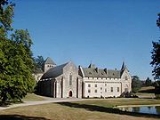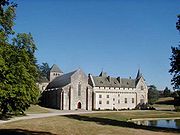
Loc-Dieu Abbey
Encyclopedia

Abbey
An abbey is a Catholic monastery or convent, under the authority of an Abbot or an Abbess, who serves as the spiritual father or mother of the community.The term can also refer to an establishment which has long ceased to function as an abbey,...
located near Martiel
Martiel
Martiel is a commune in the Aveyron department in southern France.- Gallery : -References:*...
, 9 km west from Villefranche-de-Rouergue
Villefranche-de-Rouergue
Villefranche-de-Rouergue is a commune in the Aveyron department in southern France.-History:At the end of the Albigensian Crusade from the northern "barons" against the southern Occitania on a religious pretext , the Count of Toulouse was defeated and concluded the treaty of Paris in 1229...
, in the department of Aveyron
Aveyron
Aveyron is a département in southern France named after the Aveyron River.- History :Aveyron is one of the original 83 departments created during the French Revolution on 4 March 1790....
in France
France
The French Republic , The French Republic , The French Republic , (commonly known as France , is a unitary semi-presidential republic in Western Europe with several overseas territories and islands located on other continents and in the Indian, Pacific, and Atlantic oceans. Metropolitan France...
.
Founded in 1123 in a place formerly called Locus Diaboli (Latin
Latin
Latin is an Italic language originally spoken in Latium and Ancient Rome. It, along with most European languages, is a descendant of the ancient Proto-Indo-European language. Although it is considered a dead language, a number of scholars and members of the Christian clergy speak it fluently, and...
for "devil
Devil
The Devil is believed in many religions and cultures to be a powerful, supernatural entity that is the personification of evil and the enemy of God and humankind. The nature of the role varies greatly...
's place") due to the large number of dolmen
Dolmen
A dolmen—also known as a portal tomb, portal grave, dolmain , cromlech , anta , Hünengrab/Hünenbett , Adamra , Ispun , Hunebed , dös , goindol or quoit—is a type of single-chamber megalithic tomb, usually consisting of...
s around it, it was renamed Locus Dei in Latin by the monks, which in French
French language
French is a Romance language spoken as a first language in France, the Romandy region in Switzerland, Wallonia and Brussels in Belgium, Monaco, the regions of Quebec and Acadia in Canada, and by various communities elsewhere. Second-language speakers of French are distributed throughout many parts...
became Loc-Dieu, both meaning the "place of God".
Burnt down by the English in 1409, it was rebuilt in 1470, and the abbey was fortified.
The abbey was suppressed and its assets sold off as national property by the French government during the French Revolution
French Revolution
The French Revolution , sometimes distinguished as the 'Great French Revolution' , was a period of radical social and political upheaval in France and Europe. The absolute monarchy that had ruled France for centuries collapsed in three years...
in 1793. The Cibiel family bought it in 1812, and Cibiel descendants still live in it today.
The buildings were restored in 1840 (the east wing) and in 1880 (the south and west wings).
In the summer of 1940, paintings from the Louvre
Louvre
The Musée du Louvre – in English, the Louvre Museum or simply the Louvre – is one of the world's largest museums, the most visited art museum in the world and a historic monument. A central landmark of Paris, it is located on the Right Bank of the Seine in the 1st arrondissement...
, including the Mona Lisa
Mona Lisa
Mona Lisa is a portrait by the Italian artist Leonardo da Vinci. It is a painting in oil on a poplar panel, completed circa 1503–1519...
, were hidden in Loc-Dieu to keep them safe from German troops.
The abbey and its large park are now open to visitors.
Architecture
- Church: built between 1159 and 1189, the church remains intact. This is one of the first Gothic buildings in southern France, designed by architects from Burgundy. Cistercian rules are followed, i.e the greatest simplicity possible, with no decorations other than the stone and light.
- Cloister and Chapter room: rebuilt in 1470, they replaced the previous Romanesque cloister. They present a strong Gothic style.
Gallery
External links
- Loc-Dieu Abbey, view of the west wing in front of the pond
- More pictures : www.cister.net
- Pictures from the sky : Photothèque Gaud

